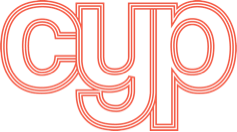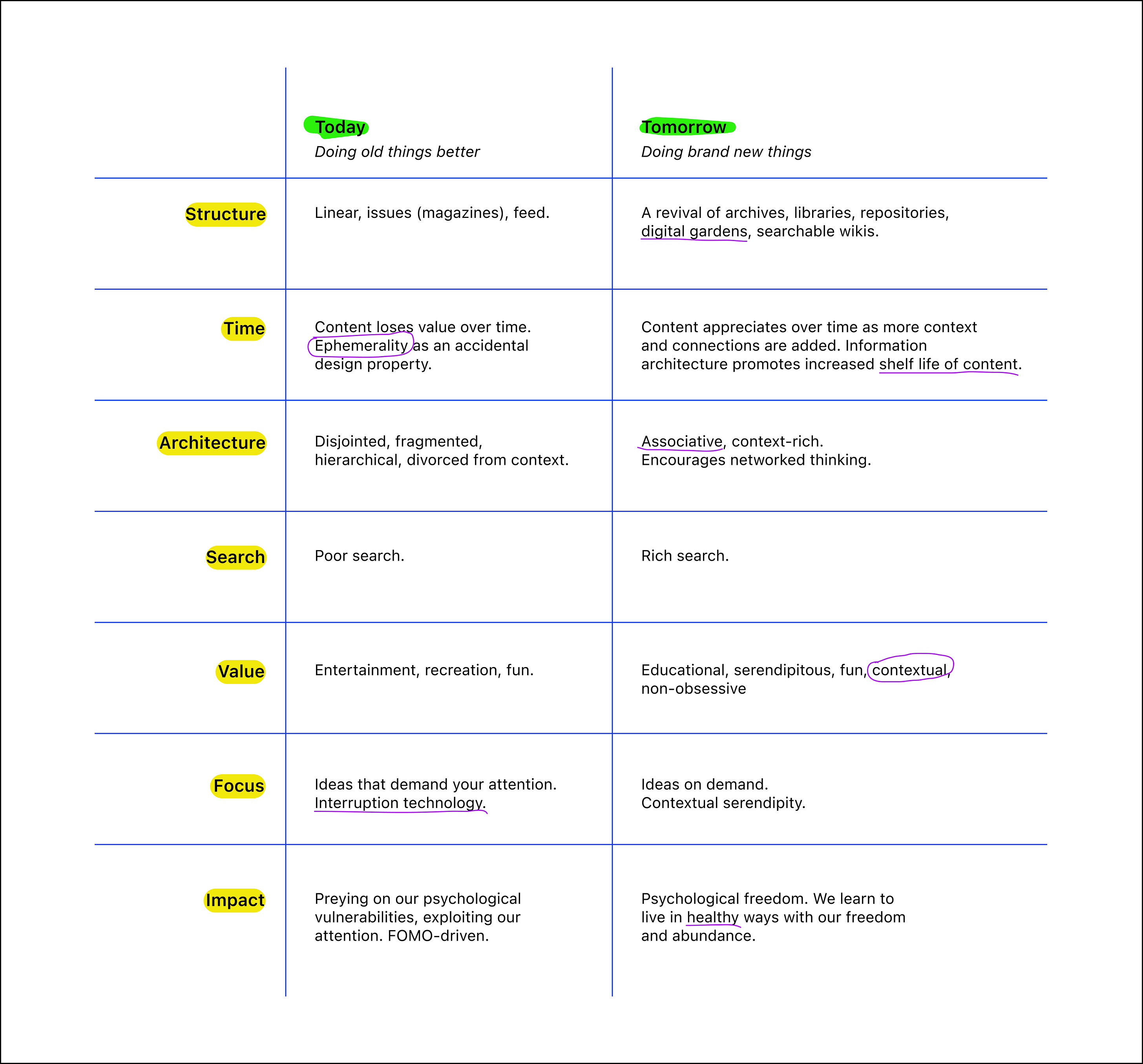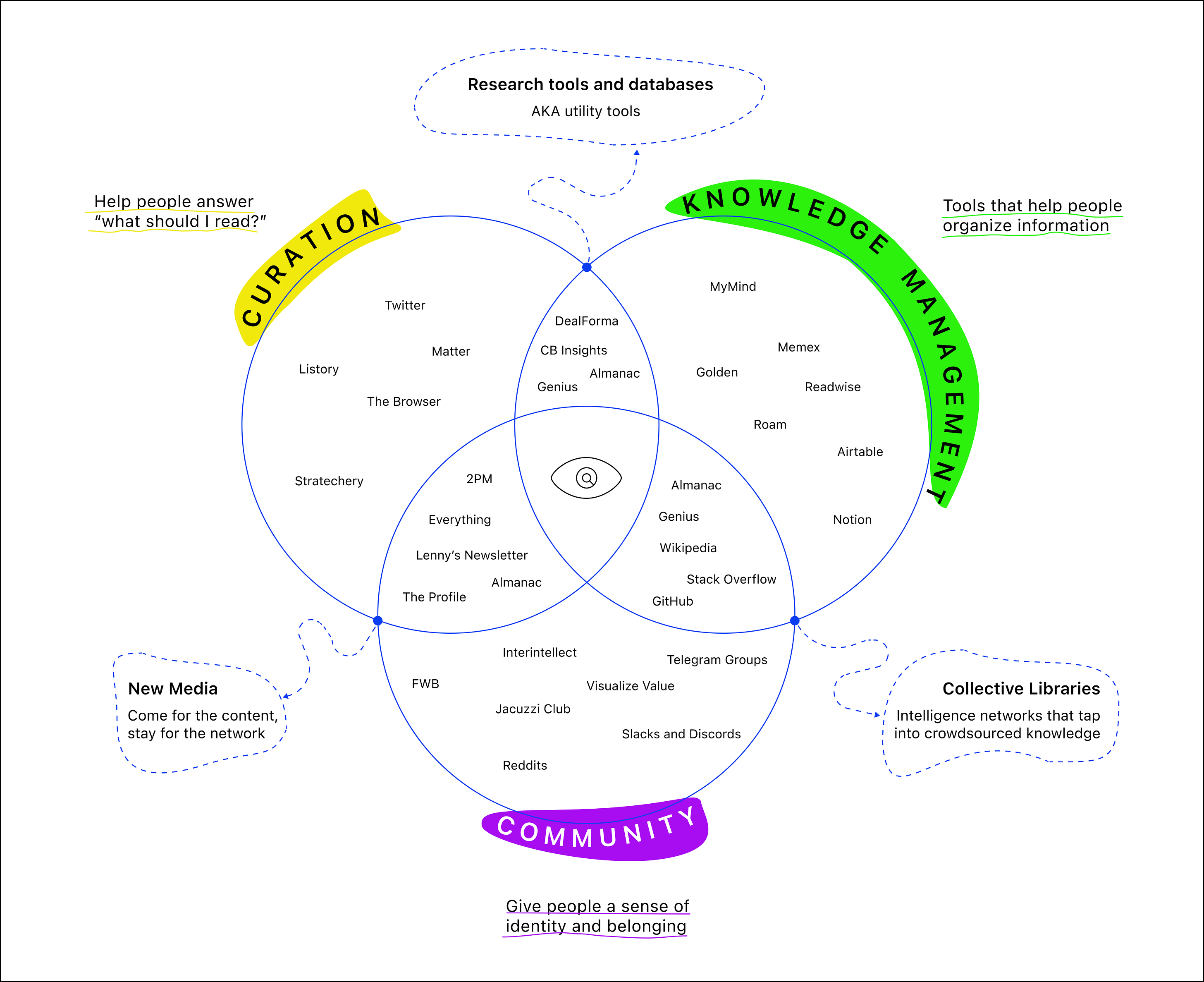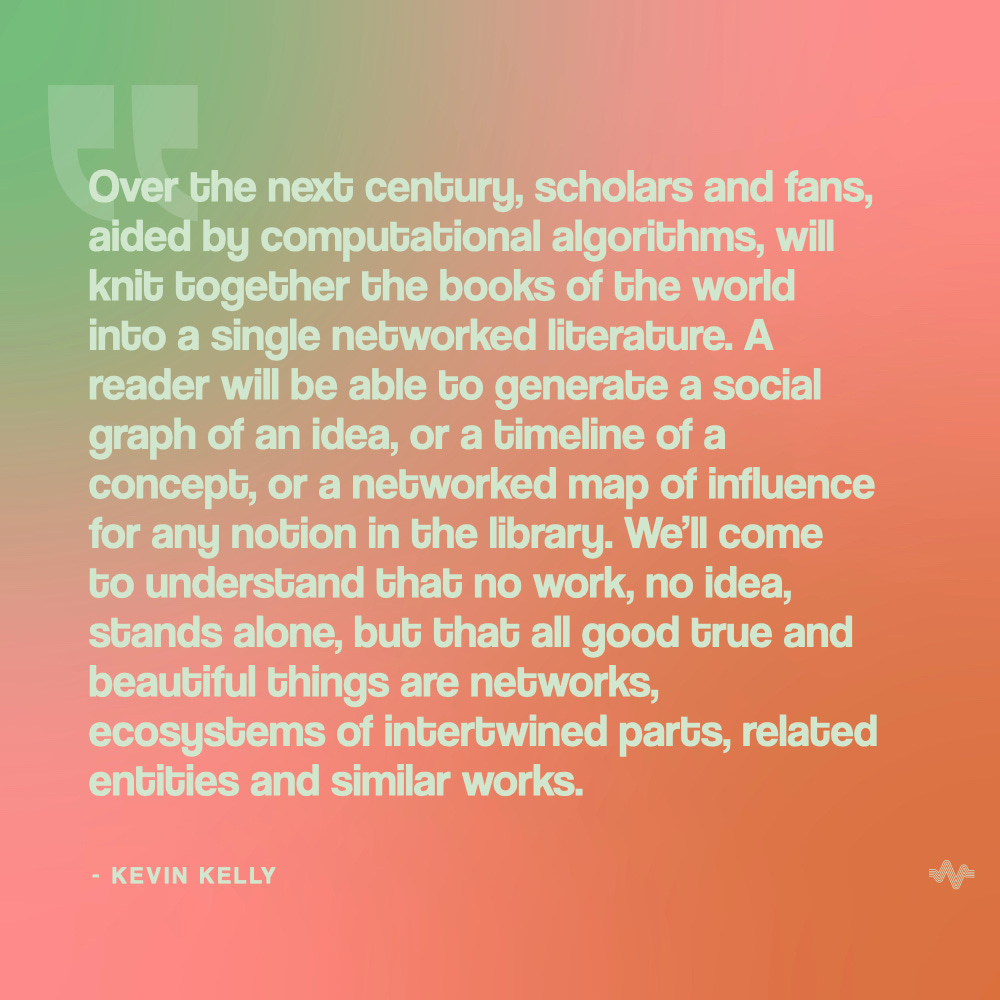Hi, I’m Sari Azout and this is the the 55th edition of Check your Pulse, a tech and startups newsletter designed to make you feel human. I try to make this one of the best emails you get every two weeks(ish).
Hellooo!!!
I’ve been MIA, I know. I’ve been watching way too much cable news, joy-scrolling through Total Landscaping memes, and working on a digital thing I wish existed.
Today’s post touches on why I think there’s an opportunity to build this thing
TL;DR
We are living through the emergence of a new business category that doesn’t even have a name yet, but which I believe will become an important part of our digital lives: online communities at the intersection of content curation and knowledge management.
I’ll be announcing what I’m working on soon.
Stay tuned ✌🏽
The Internet put thousands of years of human thought at our fingertips, and enabled billions of people to create content. At least 2.5 quintillion bytes of information are produced every day, which is approximately what was produced during all of 2002. While this presents enormous opportunities, our brains are not equipped to deal with this abundance.
In Curators are the new Creators, Gaby argues that this will create opportunities for curators – increasingly, we will pay people with good taste to help us sort through the ever-growing mass of information.
The business of good taste has been well documented. There are plenty of businesses that address the question “what should I read?”; The Browser, Listory, Matter, Everything, to name a few.
But thus far, the conversation around “curation” has been too focused on the content – “what should I read?” – and not enough on the structure – “how do we collect, store, and contextualize the information we consume?” We seem to have forgotten that the goal is not to consume more information. The goal is to think better, so we can achieve our goals.
There’s a whole economy around knowledge organization available for the taking.
Three intersecting problems remain unsolved:
Our feed-based information architecture is obsessed with the present.
We consume information recreationally, not as a way to achieve our goals.
Curation has been too focused on the information and not enough on architecture; how we collect, store, augment, and utilize what’s already in our minds.
1. Our feed-based information architecture is obsessed with the present
We seem to have accepted the job of the curator as providing a list of links with some commentary on an organized schedule. But this format is subject to the same accidental property of social media; ephemerality.
Substack makes this worse. How often have you gone back to read an old issue of your favorite newsletter? Why bother when you’ll have a new one soon? Without an information architecture that supports a longer shelf life for content, we will continue to accumulate mental and behavioral debt.
In the early days, Google helped us make sense of this abundance. I still remember when a Google search led to discovering personal blogs and hidden gems instead of results manufactured by SEO experts.
Everything that Google has done to make people stay on the page and make results more accessible has resulted in a set of editorial decisions that mean we’re no longer getting straight search results that take us away from the page, but are in some kind of Upside Down Google Funhouse Internet where the content is brought directly to us, and the internet that is brought to us is stripped of context, of the richness of the pages on their own pages, wrapped up in Google’s business logic.
These days, we turn to places like Twitter and Substack to find things that people we trust find useful. But Twitter, which was originally conceived as a platform to post personal status updates under the prompt “what are you doing?”, was never designed for the purpose of curating the world’s information stream. Their use-case was always one of obsolescence.
What’s amazing is how chronological feeds — essentially accidental experiments of digital architecture — have rewired our brains. In the feed, everything is fleeting. This design property means you’re either always on and connected, or you’re off and wondering if you’re missing something important.
In short, the architecture of digital platforms has made us obsessive documenters and consumers of the present, yet largely indifferent to the archives we create.
2. We consume information recreationally, not as a way to achieve our goals
The architecture of digital platforms encourage us to consume information because it’s in front of us, not because it’s relevant. On Twitter, nothing has to be remembered, studied, applied, or reflected on. It’s an environment that promotes distracted thinking and superficial learning.
The human brain is incredible at uncovering meaning, but is deficient at long-term memory storage. If we forget what we read, we can’t apply the knowledge to the problem at hand. We don’t need to read a long write-up on Figma’s winning strategy on a Wednesday at 11am when it hits our inbox, but we should be able to reference it if we’re building a company in the design tools space.
With our current tools, the burden of memory is left to the individual.
3. Curation has been too focused on the information and not enough on the architecture; how we collect, store, augment, and utilize what’s already in our minds
The conversation around curation thus far has focused too much on reducing the amount of information, and too little on what other architectures might be possible outside of the feeds or newsletters we’ve grown accustomed to.
While technology successfully disrupted content production, the experience of consuming content remains unchanged – the words have merely moved from a printed page to a screen.
The Internet offers us the first major opportunity to introduce new, digitally-native information architectures that improve our understanding of the world through added context and relation. 👇🏽
The past few years have seen the rise of many knowledge management tools, online communities, and curation businesses. But what’s interesting is how these categories are remixing into new combinations of content, community, and software.
Let’s take a look at this diagram 👇🏽
On the curation side, there are plenty of tools – and creator businesses – that facilitate content discovery and help us navigate abundance. As we’ve addressed, these businesses often focus on the content at the expense of the structure.
Knowledge management is becoming a hot topic again with the rise of tools designed to bring structure and order to our information stream (Anne-Laure Cunff has a great summary of the space here). These businesses take many forms, from single-player productivity tools designed for personal use (like MyMind and Readwise), to multiplayer workplace collaboration tools (like Notion and Airtable). Instead of being a destination for reading content, these tools help people organize information.
The intersection of curation and knowledge management is inhabited by utility tools like CB Insights – destinations for both reading content and organizing information. Their biggest miss is that they still function as hierarchies and have not tapped into the power of networked information and crowdsourced knowledge.
On the community side, we’re witnessing a shift towards a post-social media era defined by niche, gated communities of interest and purpose.
Some content creators, such as 2pm and Lenny’s Newsletter, are blending curation and community to inhabit a space I call: new media.
I’m of the belief that “Come for the Content, Stay for the Community” will be one of the dominating themes for media this decade. As more creators break away from companies to go subscription indie, they’ll find it to be an effective and rewarding strategy to think of ways to build ‘whole is greater than the sum of its parts’ experiences.
Most of these communities exist inside Slack, Discord, Telegram, or some other tool. But given the chat-based nature of these platforms, it’s easy to miss the best content. Without bespoke tooling to preserve knowledge, these communities will struggle with the same challenges of their early social media predecessors.
The intersection of community and knowledge management is inhabited by spaces like Genius, Stack Overflow, and other collectively maintained libraries. Wikipedia is the pinnacle example here, and remains one of the greatest wonders of the Internet age, proving the value of bespoke tooling and the feasibility of collaboration at scale.
The potential to build community-curated knowledge networks remains largely untapped. There are reasons to be optimistic; the economic feasibility of paid communities, a renewed interest in curation, a slow move away from big social, and an improved understanding of platform incentives. All combined, this will lead to communities that are more sustainable, aligned, and intentional.
The intersection of content curation, knowledge management, and community.
👀 this space.
As for the digital thing I’m building?
I’ll have more to share – and opportunities to get involved – soon.
Stay real 🙏🏼
Sari
Thank you to David Sherry, Gabriel Nessim, Toby Shorin, Marie Dolle, Prakhar Shivam, and Jad Esber for reading drafts of this post.
If you haven’t watched My Octopus Teacher on Netflix, I highly recommend it. The biggest lesson for me is how anyone can create something extraordinary just by showing up everyday. 🐙
A super interesting study on long lived institutions. The biggest surprise? 90% of the companies that are over 200 years old have 300 employees or less; they’re not mega companies. 💭
Finally got around to reading Awareness by Anthony de Mello. What a book! This line is still with me: “We see people and things not as they are, but as we are.” 📖
Fascinating read on how Nick Quah necame the podcast whisperer. More than ever, expertise seems to have become a DIY affair; strategic and determined obsession can replace specific credentials or a tangible track record.🎙️
This is one chic menorah 🕎
Fascinating thread that asks what is a sign of intelligence that most confuse with stupidity? The best answer: Mispronouncing words. It usually means someone reads at a higher level than the people around them, and thus they have only seen words in print, not heard them. 🤯
The power of visualization 👇🏽

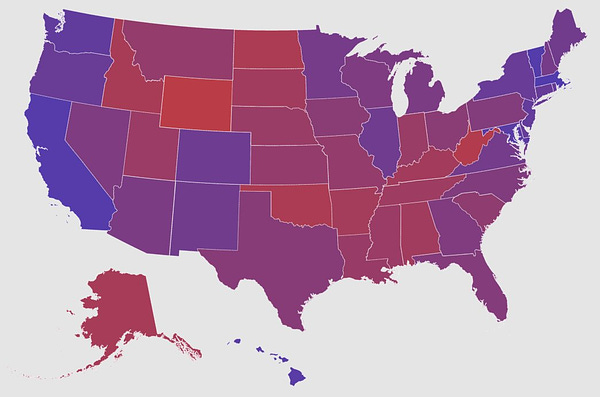
A great overview of the challenges and opportunities in the childcare industry 👶🏽
Love this from Jesse Beyroutey: We’ve found that the primary source for a company’s dominance is whether it designs its product and business model to be perfectly aligned with its customers’ interests. A great test of alignment is whether the company benefits or suffers from increased transparency. 💯
If you’re exploring a startup idea, here’s a good checklist to help you develop and filter your idea.
Cool early stage startups on my radar 🚀:
Mirror: A pre-launch publishing platform (love the design here)
Scout: Allowing fans to buy virtual trading cards of their favorite creators.
Pacaso: Democratizing access to owning a second home.
Adeft: A new take on online learning focused on doing — no courses, no certificates. Learn for 10 minutes, implement in the next 10 minutes.
Oula: A modern brick and mortar maternity center.
If you’re wondering who’s behind this newsletter:
My name is Sari Azout. I am a design-thinker, strategist, and early stage startup investor at Level Ventures. My mission is to bring more humanity and creativity to technology and business.
Want more?
Follow me on Twitter, Medium, and Instagram.
If you're enjoying this newsletter, I'd love it if you shared it with a friend. You can send them here to sign up.
Thanks for being here!
